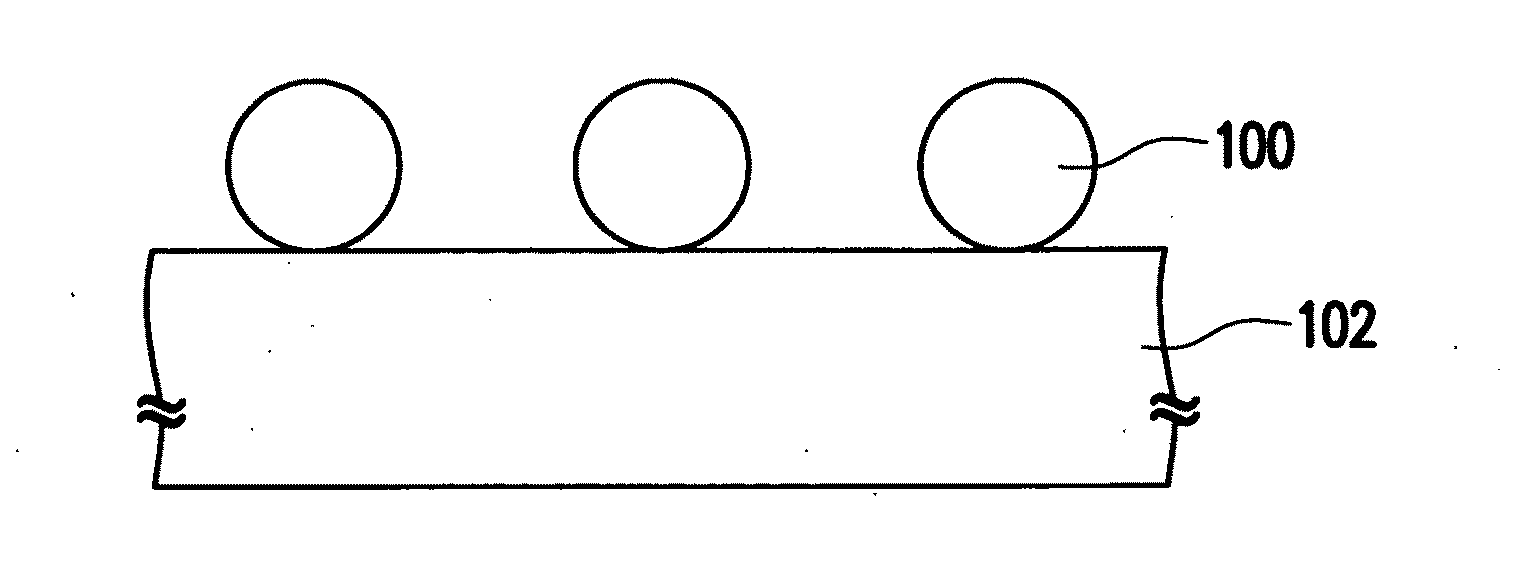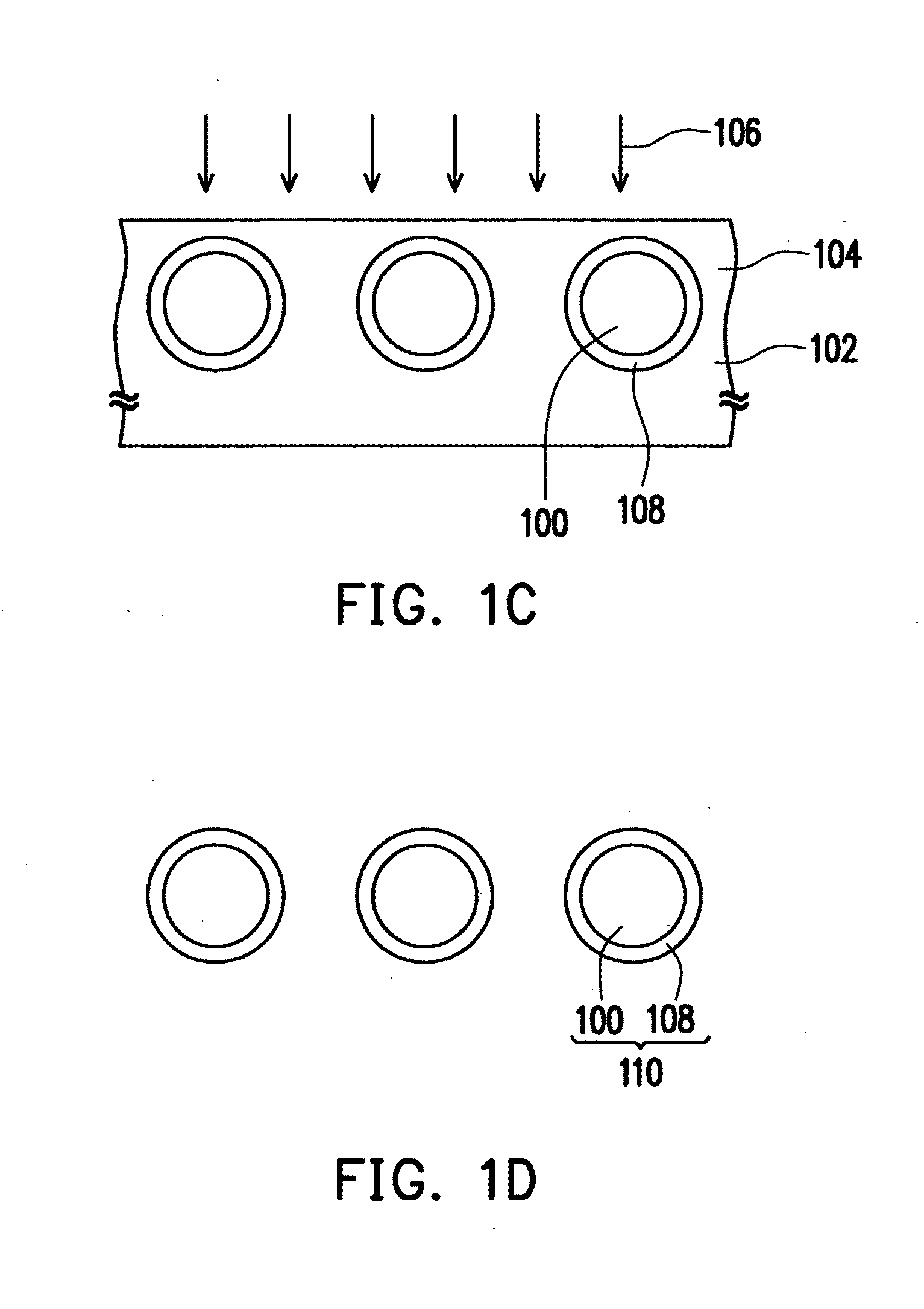Method of manufacturing core-shell nanostructure
a manufacturing method and nanostructure technology, applied in the direction of electric/magnetic/electromagnetic heating, transportation and packaging, coatings, etc., can solve the problems of limited application of core-shell nanostructure and difficult dispersion of core-shell nanostructure within organic materials
- Summary
- Abstract
- Description
- Claims
- Application Information
AI Technical Summary
Benefits of technology
Problems solved by technology
Method used
Image
Examples
first embodiment
[0045]FIG. 4A is a schematic diagram showing a gold nanoparticle on a PMMA substrate. FIG. 4B is a plot diagram showing the temperature distribution of PMMA and air at different distances to bottom of PMMA substrate when the gold nanoparticle in FIG. 4A is irradiated. FIG. 4C is a surface temperature distribution diagram of PMMA substrate. The center in this figure is the point of PMMA attached to the gold nanoparticle. As shown in FIG. 4B, the temperature at the PMMA surface attached to the gold nanoparticle is highest and the temperature in PMMA will decrease as the distance to the gold nanoparticle increases. From FIG. 4B and FIG. 4C, the range of higher temperature in PMMA is located within 10 nm around the gold nanoparticle. So we can control the temperature of the gold nanoparticle by change light intensity to control the distribution of temperature around nanoparticles for obtaining polymer shell.
second embodiment
[0046]FIG. 7 is a plot diagram showing the thermal energy distributions of CdSe nanoparticle, CdTe nanoparticle, Ag nanoparticle and Au nanoparticle irradiated by light with different wavelength. Referring to FIG. 7, by comparing with CdSe nanoparticle and CdTe nanoparticle, Ag nanoparticle and Au nanoparticle generate a larger amount of the thermal energy when Ag nanoparticle and Au nanoparticle are irradiated by a beam with a specific wavelength, such as an absorption band for exciting SPR.
[0047]Photo-thermal effect relates to the absorption of SPR and SPR depends on the size, shape, and degree of particle-to-particle coupling.
[0048]FIG. 8 shows the calculated temperature increase at the surface of single Au nanoparticle in water is a function of illumination power at the plasmon resonance. In FIG. 8, lines L1 through L6 represent the Au nanoparticles with particle sizes of 100 nm, 50 nm, 40 nm, 30 nm, 20 nm, and 10 nm in water individually irradiated by the beam with a wavelength...
third embodiment
[0052]At least one silver nanoparticle with size of 60 nm and a glass substrate are provided. Then, the silver nanoparticles are distributed onto the glass substrate by using self-assembly monolayer. The process steps are described as followings.
[0053]The glass substrate is dipped into, for example but not limited to, the nitric acid and then is dipped into ethanol with a concentration of 5%. Thereafter, the 3-aminopropyltriethoxysilane (3APTES) solution, which can be diluted by alcohols, is used as a first binder in which there are three ends of ethoxy groups and one end of —NH group and the glass substrate is dipped into the first binder. Then, the glass substrate is dipped into ethanol with a concentration of 5%. Thereafter, HS—(CH2)7-COOH, which can be diluted, is used as a second binder and the glass substrate is dipped into the second binder. Then, the glass substrate is dipped into ethanol with a concentration of 5%. At this point, the glass substrate becomes hydrophobic and ...
PUM
| Property | Measurement | Unit |
|---|---|---|
| Thickness | aaaaa | aaaaa |
| Surface plasmon resonance | aaaaa | aaaaa |
| Thermosetting | aaaaa | aaaaa |
Abstract
Description
Claims
Application Information
 Login to View More
Login to View More - R&D
- Intellectual Property
- Life Sciences
- Materials
- Tech Scout
- Unparalleled Data Quality
- Higher Quality Content
- 60% Fewer Hallucinations
Browse by: Latest US Patents, China's latest patents, Technical Efficacy Thesaurus, Application Domain, Technology Topic, Popular Technical Reports.
© 2025 PatSnap. All rights reserved.Legal|Privacy policy|Modern Slavery Act Transparency Statement|Sitemap|About US| Contact US: help@patsnap.com



